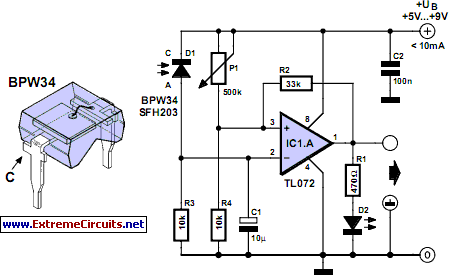Home » Circuits
Laser Alarm
This circuit is a laser alarm system like the one we see in various movies. It uses a laser pointer beam to secure your valuables and property. Essentially, when the beam gets interrupted by a person, animal or object, the resistance of a photodiode will increase and an alarm will be activated. The laser and the receiver can be fitted in same box, sharing a common power supply. As the receiver draws less than 10 mA on average, you’ll soon find that the laser is the most current hungry device! Mirrors are used to direct the beam in whatever setup you require. Examples of a passage and an area protected by the alarm are shown in the diagram.In the circuit diagram we find a TL072 op-amp (IC1.A) configured as voltage comparator between the voltage reference provided by the adjustable voltage divider P1/R4 and the light-dependent voltage provided by the voltage divider consisting of photodiode D1 and fixed resistor R3. When the laser beam is interrupted, the voltage on comparator pin 2 drops below that at pin 3, causing the output to swing to (almost) the positive supply voltage and indicating an alarm condition. This signal can drive a siren, a computer or a light that hopefully will deter the intruder.
Circuit diagram:
Alternatively it can be used to ‘silently’ trigger a more sophisticated alarm. Resistor R2 provides some hysteresis to prevent oscillation when the two comparator input voltages are almost equal. Capacitor C1 makes the circuit immune to short, accidental interruptions of the beam, e.g., by flying insects. If you want your circuit to have faster responses you can reduce its value to 1 µF. The operation of the circuit is illustrated by the waveform diagram, which also proves the hysteresis action that sets an upper and a lower threshold on the input voltage. You can also see the delay introduced by capacitor C1.
The circuit is simple and could be assembled on a piece of breadboard. After assembling the circuit and testing it, you should mount it in a black box that has just a small hole. You may decide to put the laser in the same box but only if you are sure there is no way the photodiode can ‘see’ the laser beam directly. The small hole should be filled with a black drinking straw so that only light from the direction of the laser beam can enter. With the appropriate setup of the box and the mirrors, the laser beam is so intense that even direct sunlight cannot affect the operation of the photodiode.
Author: Dimitris Kouzis-Loukas - Copyright: Elektor Electronics Magazine

